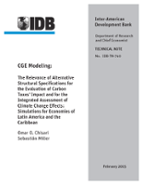CGE Modeling: The Relevance of Alternative Structural Specifications for the Evaluation of Carbon Taxes' Impact and for the Integrated Assessment of Climate Change Effects: Simulations for Economies o
Date
Feb 2015
This paper constructs a small CGE model to study the impact of carbon taxes on GDP and emissions under alternative closure rules and hypotheses (about mobility of factors, availability of alternative technologies and labor market disequilibrium). The model is simulated for Argentina, Brazil, Chile, El Salvador, Jamaica and Peru. The paper evaluates the costs of lowering emissions under different scenarios and finds that: i) those costs are lower under full employment and when international mobility of capital is limited and are higher when those taxes are not imitated by the rest of the world; ii) the compensation of carbon taxes with other taxes can help to reverse GDP and welfare losses; iii) alternative technology effective application will be reduced when it is intensive in capital from the rest of the world. The second part uses the assessment of costs of abatement of emissions with carbon taxes in an Integrated Assessment Model.



